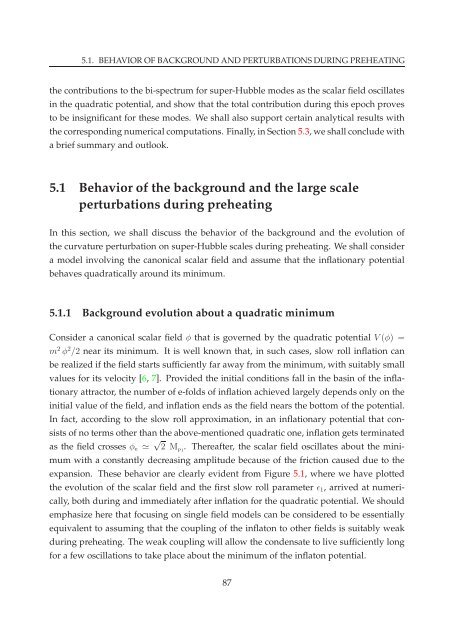PHYS08200605006 D.K. Hazra - Homi Bhabha National Institute
PHYS08200605006 D.K. Hazra - Homi Bhabha National Institute
PHYS08200605006 D.K. Hazra - Homi Bhabha National Institute
Create successful ePaper yourself
Turn your PDF publications into a flip-book with our unique Google optimized e-Paper software.
5.1. BEHAVIOR OF BACKGROUND AND PERTURBATIONS DURING PREHEATING<br />
the contributions to the bi-spectrum for super-Hubble modes as the scalar field oscillates<br />
in the quadratic potential, and show that the total contribution during this epoch proves<br />
to be insignificant for these modes. We shall also support certain analytical results with<br />
the corresponding numerical computations. Finally, in Section 5.3, we shall conclude with<br />
a brief summary and outlook.<br />
5.1 Behavior of the background and the large scale<br />
perturbations during preheating<br />
In this section, we shall discuss the behavior of the background and the evolution of<br />
the curvature perturbation on super-Hubble scales during preheating. We shall consider<br />
a model involving the canonical scalar field and assume that the inflationary potential<br />
behaves quadratically around its minimum.<br />
5.1.1 Background evolution about a quadratic minimum<br />
Consider a canonical scalar field φ that is governed by the quadratic potential V(φ) =<br />
m 2 φ 2 /2 near its minimum. It is well known that, in such cases, slow roll inflation can<br />
be realized if the field starts sufficiently far away from the minimum, with suitably small<br />
values for its velocity [6, 7]. Provided the initial conditions fall in the basin of the inflationary<br />
attractor, the number of e-folds of inflation achieved largely depends only on the<br />
initial value of the field, and inflation ends as the field nears the bottom of the potential.<br />
In fact, according to the slow roll approximation, in an inflationary potential that consists<br />
of no terms other than the above-mentioned quadratic one, inflation gets terminated<br />
as the field crosses φ e ≃ √ 2 M Pl<br />
. Thereafter, the scalar field oscillates about the minimum<br />
with a constantly decreasing amplitude because of the friction caused due to the<br />
expansion. These behavior are clearly evident from Figure 5.1, where we have plotted<br />
the evolution of the scalar field and the first slow roll parameter ǫ 1 , arrived at numerically,<br />
both during and immediately after inflation for the quadratic potential. We should<br />
emphasize here that focusing on single field models can be considered to be essentially<br />
equivalent to assuming that the coupling of the inflaton to other fields is suitably weak<br />
during preheating. The weak coupling will allow the condensate to live sufficiently long<br />
for a few oscillations to take place about the minimum of the inflaton potential.<br />
87
















